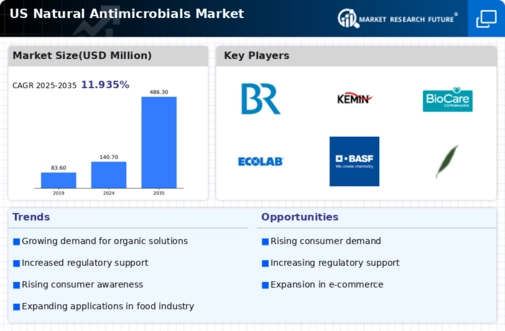Expansion of Organic Farming Practices
The natural antimicrobials market is significantly influenced by the expansion of organic farming practices across the United States. As more farmers adopt organic methods, the availability of raw materials for natural antimicrobials is increasing. This shift is not merely a trend; it represents a fundamental change in agricultural practices that aligns with consumer demand for organic products. According to recent statistics, the organic food market has grown by over 10% annually, which in turn supports the natural antimicrobials market. The integration of natural antimicrobials in organic farming not only enhances product safety but also meets regulatory standards, further solidifying their role in sustainable agriculture. This synergy between organic farming and natural antimicrobials is likely to foster innovation and create new opportunities for growth within the industry.
Increased Regulatory Focus on Food Safety
The natural antimicrobials market is benefiting from an increased regulatory focus on food safety in the United States. Regulatory bodies are emphasizing the need for safer food preservation methods, which has led to a heightened interest in natural antimicrobials as viable alternatives to synthetic preservatives. This regulatory environment is fostering innovation and encouraging manufacturers to explore natural solutions that comply with safety standards. Recent reports indicate that the market for natural preservatives is projected to grow by 12% annually, driven by these regulatory changes. As food safety concerns continue to rise, the natural antimicrobials market is likely to expand, providing opportunities for companies to develop compliant and effective products that cater to both consumer preferences and regulatory requirements.
Growing Demand in the Personal Care Sector
The natural antimicrobials market is witnessing a growing demand within the personal care sector, as consumers increasingly seek products that are free from harmful chemicals. This trend is particularly evident in skincare and cosmetic products, where the incorporation of natural antimicrobials is perceived as a safer and more effective option. Market analysis indicates that the personal care segment is expected to account for approximately 30% of the overall natural antimicrobials market by 2026. This shift is prompting manufacturers to reformulate their products, integrating natural ingredients that not only enhance product efficacy but also align with consumer values regarding health and sustainability. As the personal care industry continues to evolve, the natural antimicrobials market is likely to experience sustained growth driven by this consumer preference.
Rising Consumer Awareness of Health Benefits
The natural antimicrobials market is experiencing a notable surge in consumer awareness regarding the health benefits associated with natural ingredients. As individuals become increasingly informed about the potential risks of synthetic additives, there is a growing preference for products that utilize natural antimicrobials. This shift is reflected in market data, indicating that the demand for natural alternatives has risen by approximately 15% over the past year. Consumers are actively seeking products that not only enhance safety but also promote overall well-being. This trend is particularly pronounced in sectors such as food and personal care, where the incorporation of natural antimicrobials is perceived as a healthier choice. Consequently, manufacturers are compelled to innovate and reformulate their offerings to align with consumer expectations, thereby driving growth in the natural antimicrobials market.
Technological Advancements in Extraction Methods
Technological advancements in extraction methods are playing a pivotal role in the natural antimicrobials market. Innovations such as supercritical fluid extraction and cold pressing are enhancing the efficiency and efficacy of extracting active compounds from natural sources. These methods not only improve yield but also preserve the integrity of the antimicrobial properties, making them more appealing to manufacturers. As a result, the market is witnessing a diversification of products that utilize these advanced extraction techniques. Data suggests that the adoption of such technologies could potentially increase production efficiency by up to 20%, thereby reducing costs and enhancing competitiveness. This trend indicates a promising future for the natural antimicrobials market, as companies strive to leverage these advancements to meet growing consumer demands for effective and safe products.




















Leave a Comment